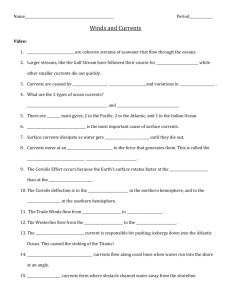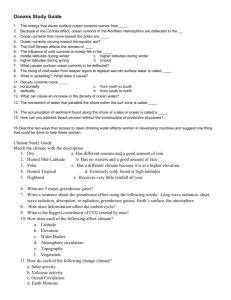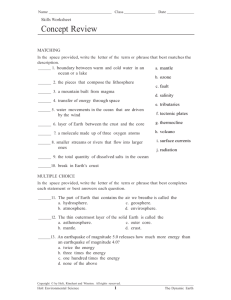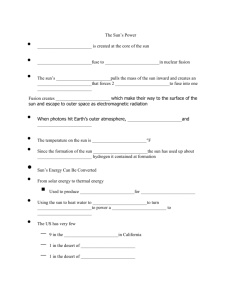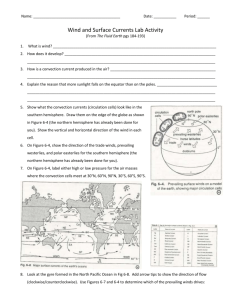Ocean-Circulation-Lecture-Notes
advertisement
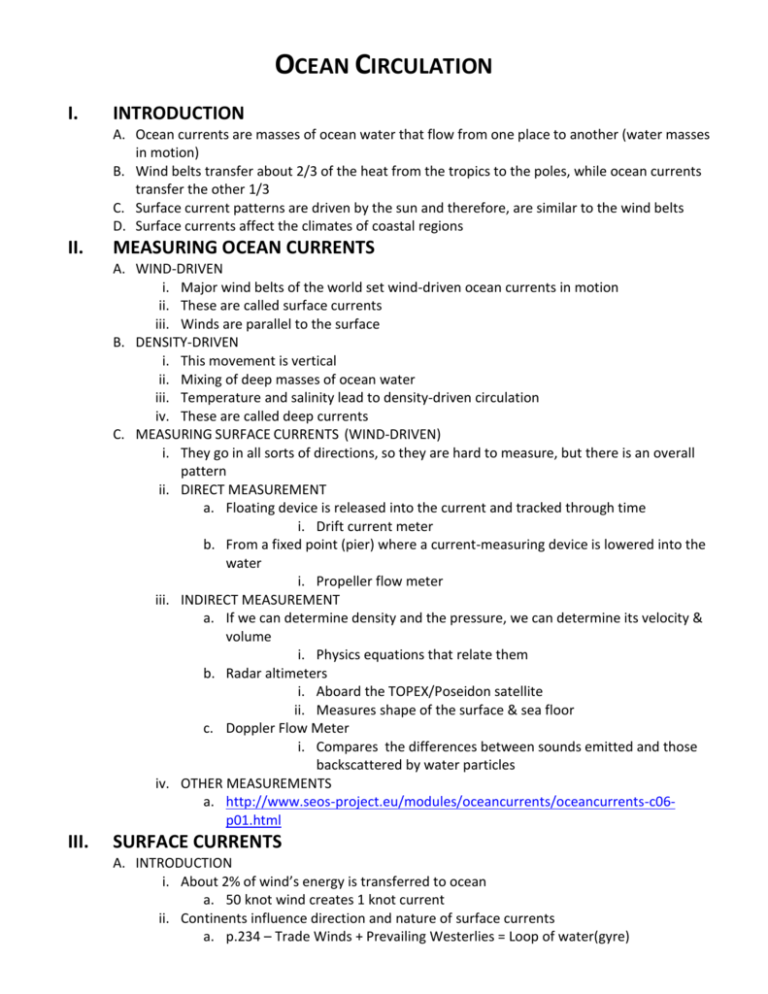
OCEAN CIRCULATION I. INTRODUCTION A. Ocean currents are masses of ocean water that flow from one place to another (water masses in motion) B. Wind belts transfer about 2/3 of the heat from the tropics to the poles, while ocean currents transfer the other 1/3 C. Surface current patterns are driven by the sun and therefore, are similar to the wind belts D. Surface currents affect the climates of coastal regions II. MEASURING OCEAN CURRENTS A. WIND-DRIVEN i. Major wind belts of the world set wind-driven ocean currents in motion ii. These are called surface currents iii. Winds are parallel to the surface B. DENSITY-DRIVEN i. This movement is vertical ii. Mixing of deep masses of ocean water iii. Temperature and salinity lead to density-driven circulation iv. These are called deep currents C. MEASURING SURFACE CURRENTS (WIND-DRIVEN) i. They go in all sorts of directions, so they are hard to measure, but there is an overall pattern ii. DIRECT MEASUREMENT a. Floating device is released into the current and tracked through time i. Drift current meter b. From a fixed point (pier) where a current-measuring device is lowered into the water i. Propeller flow meter iii. INDIRECT MEASUREMENT a. If we can determine density and the pressure, we can determine its velocity & volume i. Physics equations that relate them b. Radar altimeters i. Aboard the TOPEX/Poseidon satellite ii. Measures shape of the surface & sea floor c. Doppler Flow Meter i. Compares the differences between sounds emitted and those backscattered by water particles iv. OTHER MEASUREMENTS a. http://www.seos-project.eu/modules/oceancurrents/oceancurrents-c06p01.html III. SURFACE CURRENTS A. INTRODUCTION i. About 2% of wind’s energy is transferred to ocean a. 50 knot wind creates 1 knot current ii. Continents influence direction and nature of surface currents a. p.234 – Trade Winds + Prevailing Westerlies = Loop of water(gyre) iii. They are affected by a. Gravity b. Friction c. Coriolis Effect iv. Occur above the pycnocline to about 1 km v. Affect only about 10% of the world’s ocean water B. GENERAL DEFINITIONS – IDEAL CONDITIONS i. EQUATORIAL CURRENTS a. The NE & SE trade winds converge at the equator, creating a major wind movement from East to West b. These are called Equatorial currents c. They are warm water since they are at the equator ii. WESTERN BOUNDARY CURRENTS a. Since the equator goes through land masses, currents hit continents and change direction b. Coriolis effect makes them away from the equator, going North or South c. They travel along the Eastern side of a continent, which is the Western side of the ocean basin d. Therefore, they are called Western Boundary Currents e. These bring warm water north toward the poles iii. EASTERN BOUNDARY CURRENTS a. The prevailing westerlies pull these surface currents away at an easterly angle from the equator (NE or SE) b. Coriolis affect brings them back toward the equator c. This pull downward is along the western side of a continent, but the eastern side of the ocean basin d. Therefore, they are called Eastern Boundary Currents e. They carry cool water away from the poles toward the equator iv. GYRES a. This entire process create a loop of surface currents, a gyre b. There are 5 basic subtropical gyres i. North Atlantic (clockwise) ii. South Atlantic (counterclockwise) iii. North Pacific (clockwise) iv. South Pacific (counterclockwise) v. Indian Ocean (counterclockwise) c. There are about 5 basic subpolar gyres that operate similarly i. North Atlantic gyre (counterclockwise) ii. Alaskan gyre (counterclockwise) iii. Weddell Gyre (clockwise) iv. Ross Gyre (clockwise) v. 1 unnamed (clockwise) v. MAP OF SURFACE CURRENTS a. Additional sheet b. These need to be memorized! c. http://www.youtube.com/watch?v=xusdWPuWAoU C. FORMATION OF SURFACE CURRENTS (FOUR MAIN METHODS) i. EKMAN SPIRAL & EKMAN TRANSPORT a. EKMAN SPIRAL i. 45o to the right due to Coriolis ii. There are different “thin” layers of water, affected by the friction of the layer above iii. Energy is passed down and decreases with depth iv. At about 300 ft down, there is no more Ekman spiral – depth of frictional influence b. EKMAN TRANSPORT i. If you look at all of the layers, there is a general trend of 90o to the right of the wind ii. This average movement is called Ekman transport iii. This follows along with the Coriolis effect ii. CONVERGENCE a. Clockwise rotation in the Northern hemisphere would deflect water to the right b. This would mean that surface currents would converge in the middle of the gyre c. This can be as much as 2 meters iii. VORTICITY (CONSERVATION OF) a. Vorticity is analgous to angular velocity i. Angles/Rotations per time b. As you head away from the equator, vorticity increases/decreases iv. GEOSTROPHIC BALANCE a. The Coriolis Effect opposes gravity, deflecting water to the right b. Gravity brings down water back into the hill c. This creates a geostrophic current D. WESTERN INTENSIFICATION i. The balance of wind stress, Coriolis Effect and friction is not perfectly symmetrical in the middle of a gyre ii. Also, Earth rotates toward the East, pushing water to the West a bit iii. In fact, the apex of a hill tends to be closer to the western boundary of a gyre iv. This is known as western intensification v. The western boundary currents of all subtropical gyres are western intensified, even in the Southern Hemisphere E. EQUATORIAL COUNTERCURRENTS i. The westward currents flow until they hit the continents ii. This water will go under and back, counter to and between, the equatorial currents F. OCEAN CURRENTS AND CLIMATE i. Ocean Currents effect the climate ii. Continental margins with warm currents off the coast typically have a humid climate iii. Conversely, continental margins with cold currents off the coast typically have an arid climate IV. UPWELLING AND DOWNWELLING A. DEFINITIONS i. Upwelling is the vertical movement of cold, deep, nutrient-rich water to the surface a. Since the water is cold, a lot of dissolved nutrients are there b. This adds to productivity ii. Downwelling is the vertical movement of warm, surface water to deeper parts of the ocean B. DIVERGING SURFACE WATER i. The currents are diverging – pushing away from each other ii. Some water must replace the movement iii. Hence, you have equatorial upwelling C. CONVERGING SURFACE WATER i. The currents are converging – moving toward each other ii. Water stacks up and can only go downward iii. Hence, you have downwelling D. COASTAL UPWELLING & DOWNWELLING i. Southern Hemisphere, winds coming from south, eastern boundary current, along western side of continent, waters would pull away (to the left) from the coast a. Water rises to replace b. You have coastal upwelling ii. Southern Hemisphere, winds coming from north, eastern boundary current, along western side of continent, waters would push toward (to the left) from the coast a. Water piles up b. You have coastal downwelling E. OTHER UPWELLING i. Offshore winds, pushing water out a. Land breeze ii. Sea Floor obstruction a. Tablemount iii. Sharp Bend in Coastline iv. No pycnocline a. Both upwelling and downwelling can occur V. SURFACE CURRENTS OF THE OCEANS A. ANTARCTIC OCEAN i. ANTARCTIC CIRCUMPOLAR CURRENT a. Aka West Wind Drift b. Flows west to east c. 40-65o south latitude d. Subtropical convergence represents northern boundary of current e. Strong winds created i. Roaring Forties ii. Furious Fifties iii. Screaming Sixties f. Only current to completely circumscribe Earth g. Transports more water than any other surface current ii. ANTARCTIC CONVERGENCE a. At around 50o latitude south latitude b. Marks the northern boundary of the Southern Ocean c. Downwelling since it’s a convergence iii. EAST WIND DRIFT a. A surface current propelled by the polar easterlies b. Moves west to east c. Opposite that of the Antarctic Circumpolar current iv. ANTARCTIC DIVERGENCE a. Since the East Wind Drift and the West Wind Drift flow in opposite directions, a divergence is created b. Upwelling occurs B. C. D. E. c. Very productive ATLANTIC OCEAN i. NORTH & SOUTH ATLANTIC GYRES a. North Atlantic goes clockwise b. South Atlantic goes counterclockwise c. Atlantic Equatorial Current flows between them d. SOUTH GYRE i. South Equatorial Current splits into two around Brazil ii. West Wind Drift brings it to the Benguela current, completing the gyre iii. Falkland current is in there (aka Malvinas) e. NORTH GYRE i. Gulf Stream is most studied ii. North Equatorial current moves parallel to Equator iii. Flow splits into Antilles & Caribbean Current iv. Reconverge as Florida current v. Gulf Stream is western intensified vi. Sargasso Sea is east of Gulf Stream vii. Meanders disconnect from Gulf Stream and create eddies or rings 1. Warm core (clockwise) 2. Cold core (counterclockwise) 3. Last for months 4. 15 per active year 5. http://kingfish.coastal.edu/gulfstream/p5.htm PACIFIC OCEAN i. North Pacific Gyre a. Kuroshio Current i. aka Japan Current b. North Pacific Current c. California Current d. Alaskan Current ii. South Pacific Gyre a. East Australian Current b. Peru Current PACIFIC OCEAN - WALKER CIRCULATION CELLS (& UNDER NORMAL CONDITIONS) i. High Pressure & Low Pressure regions ii. Strong southeast trade winds blow across to low pressure iii. Warm air rises, creating precipitation iv. Upwelling along western coast of South America v. ANIMATION!! PACIFIC OCEAN - EL-NINO SOUTHERN OSCILLATION (ENSO) i. EL NINO (WARM PHASE) a. The high pressure area weakens b. Trade winds diminish i. May actually reverse! c. Band of warm water stretches across Pacific i. Kelvin wave d. Typically starts to move in September of an El Nino year and reaches South America by December/January e. Thermal expansion f. Affects weather & productivity & organisms g. Thermocline stays horizontal, therefore upwelling isn’t bringing nutrient-rich water to surface h. Sometimes, downwelling actually occurs i. Cause drought in Indonesia & Australia ii. LA NINA (COOL PHASE) a. Typically occur after an EL NINO b. The high pressure area strengthens c. Trade winds strengthen d. Band of cold water stretches across Pacific i. Does not impede warm water though e. Way more upwelling f. Thermocline rises and shrinks iii. OCCURANCE a. El Nino occurs on average every 2-10 years b. Typically last 12-18 months c. However, it’s very irregular F. INDIAN OCEAN i. Winds have a seasonal pattern, a monsoon ii. During winter, land rapidly cools, creating winds toward the south – Northeast monsoon iii. During summer, land rapidly warms, creating winds toward the north – Southwest monsoon iv. Somali current v. Indian Ocean Gyre vi. Agulhas Current vii. West Australian Current VI. DEEP OCEAN CURRENTS A. THERMOHALINE CIRCULATION ORIGIN i. Increase in density means decrease in temperature and increase in salinity ii. It starts at high latitudes at the surface iii. Salinity increases as sea ice forms iv. It sinks, initiating deep-ocean currents v. At the same time, less dense, deep-water masses are rising to the surface B. SOURCES OF DEEP WATER / DEEP WATER FORMATION i. ANTARCTICA (beneath ice along continent) a. Rapid winter freezing produces very cold, highly-dense water b. Sinks down slope of Antarctica c. Near Weddell Sea d. This creates Antarctic Bottom Water (AABW), which is deep water e. Returns to the surface about 1000 years later ii. NORWEIGAN SEA / MARGINS OF IRMINGER SEA / LABRADOR SEA / GREENLAND SEA a. Flows as a subsurface current into the North Altantic b. This creates North Atlantic Deep Water (NADW) iii. ANTARCTIC CONVERGENCE a. Sinking because of convergence b. Not cold enough or salty enough to reach sea floor c. This creates Antarctic Intermediate Water (AAIW) C. PACIFIC & INDIAN OCEANS i. No source of Northern Hemisphere deep water ii. They lack a deep water mass iii. In Northern Pacific, low salinity surface waters prevents sinking iv. In Northern Indian, surface waters are too warm to sink v. When AABW & NADW mix, it creates Oceanic Common Water a. Lines bottoms of both basins b. aka circumpolar water D. CONVEYER BELT CIRCULATION i. Beginning in the North Atlantic, surface water carries heat to high latitudes via the Gulf Stream ii. Movement of Oxygen


